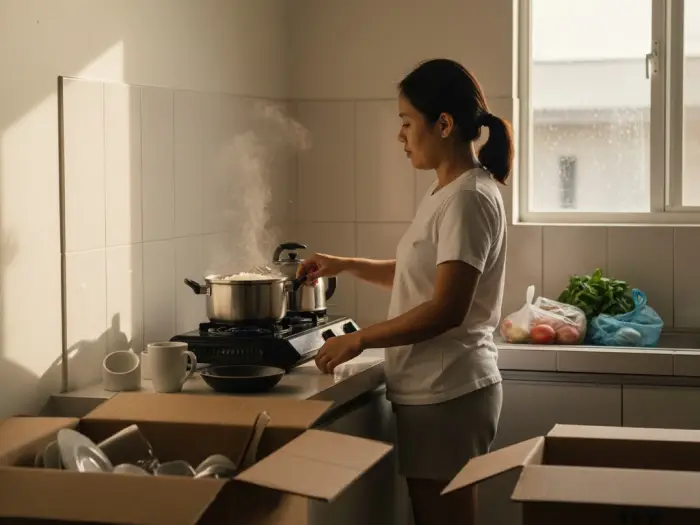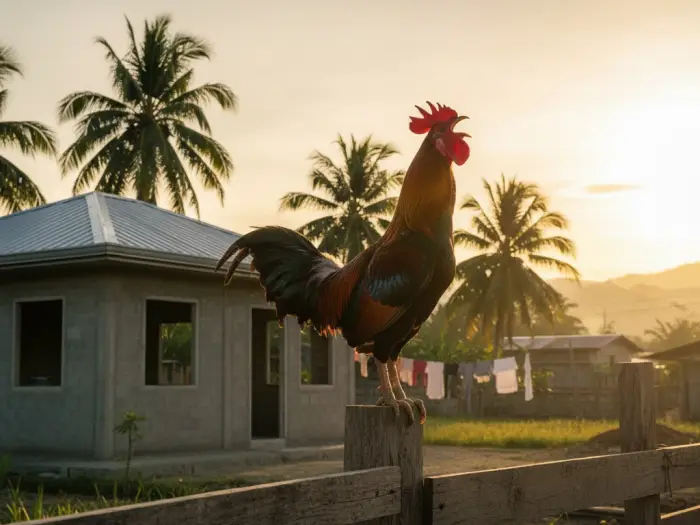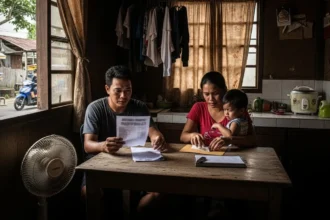For Filipinos, moving into a new house isn’t just about furniture and keys – it’s about inviting luck, peace, and prosperity into a new chapter of life. Whether it’s a humble bahay kubo or a modern townhouse, every move starts with a few whispered pamahiin from lola: toss some coins, scatter rice, boil water, say a prayer.
- 🕯️ 1. The Bisperas or First Night in the New Home
- 🪙 2. Scattering Coins, Rice, and Salt – Pera’t Asin sa Paglipat-Bahay
- 🐾 3. Letting the Cat Enter First – Pusa Muna sa Pinto
- 🔥 4. Boiling Water and Cooking Rice on the First Day
- 🕊️ 5. The House Blessing – Pa-Bless ng Bagong Tahanan
- 🎉 6. Hosting the Housewarming Feast – Handaan sa Paglipat
- 🥖 7. Bringing Rice, Water, and Bread Before Anything Else
- 🛋️ 8. Avoiding Empty Rooms and Silent Nights
- 🧺 9. Sweeping Out the Bad Energy – Ang Unang Walis sa Bagong Bahay
- 🐓 10. The Rooster’s Call and Other Signs of Good Fortune
- ❓ FAQs About Filipino New House Traditions
- 🌿 More Than Luck – It’s About Home
- 🧭 References
These small rituals – some old as our grandparents, others born from pure Pinoy practicality – carry the same wish: “Sana masagana, tahimik, at mapayapa ang bagong tahanan.”
In this article, we’ll walk through 10 Filipino moving-in and house blessing customs, from why coins must roll first to how salt keeps away bad spirits. Because for us, a house isn’t just built with cement – it’s built with faith, tradition, and a little bit of swerte.
🕯️ 1. The Bisperas or First Night in the New Home
In Filipino culture, the first night in a new house – called the bisperas – sets the tone for all the days to come. That’s why moving in isn’t done casually; it’s planned with oras ng swerte and a touch of ceremony.
Most families choose to sleep in the house the night before the official move, even if there’s no furniture yet. Some bring only the basics – a mat, rice, salt, water, and candles – and spend the night together, saying prayers or the rosary. The belief is simple: kung saan ka unang matulog, doon sisimulang pumasok ang biyaya.
Some even consult the lunar calendar for the most auspicious day – avoiding Fridays or the 13th, which are considered unlucky by older generations. Others move in during early morning or just before sunset, believing those times attract calm energy and good beginnings.
Lighting a candle on the first night is also common. It’s said to invite divine light and drive away negative spirits, especially in an unblessed house. The soft glow symbolizes safety – the family’s way of saying, “Mula ngayon, may ilaw at buhay na sa tahanang ito.”
Even renters follow this practice, spending their first night with a simple dinner and short prayer. It’s not superstition – it’s Filipino intuition: starting fresh, with gratitude and light.

🪙 2. Scattering Coins, Rice, and Salt – Pera’t Asin sa Paglipat-Bahay
This is one of the most well-known Filipino moving-in rituals – scattering coins, rice, and salt as soon as you enter your new home. Lola will always say, “Para pumasok ang swerte at huwag pumasok ang malas.”
The moment the doors open, someone – usually the mother or eldest in the family – steps in first carrying a tray or bowl filled with uncooked rice, a pinch of salt, and loose coins. These are sprinkled or tossed in different corners of the house, especially near the main entrance and kitchen.
Each item carries its own meaning:
- Rice symbolizes food and abundance – the hope that the family will never go hungry.
- Coins represent financial prosperity and continuous flow of money.
- Salt wards off negative energy and evil spirits, a practice that dates back to pre-colonial times when salt was considered both sacred and purifying.
In some regions, people add sugar for sweetness or sprinkle holy water alongside the rice and salt for extra blessing. Others even let kids gather the scattered coins afterward, a playful way of “spreading the luck.”
It’s also common to leave a handful of rice and salt by the front door overnight to “guard” the home during its first evening. By morning, families say the new house is officially malas-free and ready to welcome its owners.
Whether you believe in luck or not, there’s something deeply comforting about these gestures. It’s not just superstition – it’s gratitude, a humble way of saying, “Salamat, may tahanan na tayo.”

🐾 3. Letting the Cat Enter First – Pusa Muna sa Pinto
You’ve probably heard this one from your parents or lola: “Huwag kayong mauunang pumasok, pusa muna!”
According to Filipino tradition, a cat should be the first living being to enter the new house before the family officially moves in. The belief is that cats have a strong sense of territory and instinct – if they settle calmly, it means the home is peaceful and free from bad spirits. But if they hiss or act restless, aba, baka may hindi kanais-nais na presensya sa loob.
This custom likely originated from both Chinese and indigenous influences, where animals were seen as sensitive to unseen energies. In some parts of the Philippines, families even “borrow” a cat from a neighbor just for the ritual. It doesn’t matter what color – though puting pusa (white cat) is often favored for purity and calm.
Once the cat enters, it’s allowed to roam freely. If it goes straight to the kitchen or bedroom and lies down, that’s considered a good omen – parang sinasabing, “comfortable ako dito.” Some people also sprinkle rice grains near the door for the cat to play with, symbolizing abundance and harmony.
In modern times, not every family owns a cat – but the meaning behind the ritual remains strong. It’s about testing the “energy” of the home and ensuring that peace comes first before people. Because for Filipinos, a house may be empty at first, but the moment it welcomes life – even a curious little pusa – it begins to feel like home.

🔥 4. Boiling Water and Cooking Rice on the First Day
No Filipino lipat-bahay is complete without boiling water and cooking rice the moment you move in. Before you plug in the TV or unbox the appliances, lola will always say, “Magpakulo ka muna ng tubig at magsaing, para tuloy-tuloy ang biyaya.”
This tradition is all about welcoming warmth and life into the new home. Boiling water represents the start of flow – of energy, blessings, and daily sustenance. Cooking rice, on the other hand, symbolizes food security – the hope that the family will never go hungry under this roof.
Some families even make it a rule that the very first meal cooked in the new kitchen must be kanin at asin or lugaw – simple food shared by everyone in the house. It’s not about luxury, but about grounding: the reminder that even the simplest meal, when shared in love, makes a house feel alive.
There’s also a practical side. Back when houses had no running water or electricity yet, boiling water was the first step to ensure the home was safe and habitable. Over time, this practical act became a spiritual one – isang paanyaya sa swerte, init, at kabuhayan.
To this day, you’ll still see new homeowners filling their kettles or rice cookers before anything else. And as that first puff of steam rises from the pot, it feels symbolic – like the house is taking its first breath, saying, “Handa na akong maging tahanan.”

🕊️ 5. The House Blessing – Pa-Bless ng Bagong Tahanan
One of the most important Filipino lipat-bahay traditions is the house blessing, fondly called pa-bless. It’s the spiritual heart of every move – a way of dedicating the home to God’s protection and cleansing it of negative energy before fully settling in.
Typically, a priest or pastor is invited to conduct the ceremony. Families prepare a small altar or table with holy water, a crucifix, candles, and food offerings. During the blessing, prayers are said in every room as holy water is sprinkled along the walls and doors – isang basbas ng kapayapaan at pag-asa sa bagong simula.
For Catholic families, it’s usually followed by a short mass and a communal meal (salusalo), where friends and relatives join in celebration. In some provinces, a barangay kagawad or elder performs the blessing with traditional rituals – burning incense, waving palm leaves, or reciting prayers of protection.
Modern pa-bless ceremonies have adapted with time. Some families invite only close relatives, while others hold a virtual blessing for loved ones abroad. Others combine faiths – blending Christian prayers with Chinese incense or feng shui for extra luck.
No matter the form, the message remains the same: may this house be filled with joy, love, and protection. After all, Filipinos see a home not just as shelter, but as sacred ground – isang tahanang may basbas ng Diyos at init ng pamilya.

🎉 6. Hosting the Housewarming Feast – Handaan sa Paglipat
Once the blessing is done, it’s time for the most Filipino part of any new beginning – the handaan! The housewarming feast is more than just celebration; it’s a gesture of gratitude and a warm invitation for family, friends, and neighbors to share in the joy of the new home.
Filipinos believe that the first gathering inside a new house should be filled with laughter, food, and noise – para masanay ang bahay sa saya, hindi sa katahimikan. Some say it wards off loneliness and brings continuous happiness within its walls. Others simply see it as a way to say salamat to those who helped along the journey.
Tables overflow with familiar dishes: pancit for long life, lechon or roasted chicken for abundance, and sweet treats like biko or maja blanca for sweetness in the years ahead. Guests are often encouraged to eat heartily and walk through the house, “spreading” good energy as they go.
It’s also customary to let guests bring small housewarming gifts – often practical items like salt, candles, dish towels, or rice – each with symbolic meaning. Even something as simple as a plant or fruit basket is seen as a blessing for growth and prosperity.
Some modern families combine the handaan with a potluck or barbecue night, mixing tradition with convenience. But whether big or small, one thing remains true: a Filipino home isn’t truly complete until it’s been filled with the smell of food, the sound of laughter, and the warmth of people you love.

🥖 7. Bringing Rice, Water, and Bread Before Anything Else
Ask any lola what to bring first when moving in, and she’ll say without hesitation: “Bigas, tubig, at tinapay muna – bago lahat!”
This simple but powerful pamahiin teaches that the first items to enter a new home should symbolize basic needs and daily blessings. Rice represents food and sustenance, water stands for life and flow, and bread (or any staple) signifies continuous nourishment. Together, they form a prayer: “Walang gutom, walang uhaw, walang kulang sa tahanang ito.”
Traditionally, the eldest family member carries these items through the front door first, before furniture, appliances, or even people. It’s their way of inviting abundance and stability to settle in before everything else. Some add salt or sugar to the bundle for protection and sweetness.
In the provinces, people sometimes wrap the rice and bread in a clean white cloth – believed to keep the blessings pure. Others place the items straight onto the dining table and say a short prayer of gratitude.
Even modern homeowners who don’t believe in pamahiin often keep this tradition alive – partly out of respect, partly because it just feels right. After all, moving into a home stocked with food and water isn’t just symbolic luck – it’s practical, nurturing, and deeply Filipino.
Because in our culture, a house becomes a tahanan only when it first welcomes nourishment and grace.

🛋️ 8. Avoiding Empty Rooms and Silent Nights
In the Philippines, an empty house is never left completely quiet – especially during the first few nights. Elders warn, “Huwag mong hayaang tahimik o madilim ang bahay, baka pasukin ng lamig o malas.”
This belief comes from the idea that a new home must get used to movement, warmth, and laughter. Silence, in old Filipino superstition, invites loneliness – or worse, unwanted spirits looking for space to settle in. That’s why families often leave a light on overnight or play soft music in the living room during their first week.
Some even say every room should have a sign of life – a piece of furniture, a chair, or even a small lamp – to remind the house that it’s lived in. The point isn’t fear; it’s comfort. In rural areas, people used to sleep with the radio quietly playing or kids running around late just so “masanay ang bahay sa ingay.”
Practically speaking, it also makes sense. New houses can creak and echo in silence, making them feel eerie. So filling them with gentle sound and light eases that unsettling feeling – parang sinasanay mo ang bahay sa saya at sigla ng pamilya.
Even today, you’ll still hear laughter spilling from freshly moved-in homes at midnight – karaoke, TV, or kids chasing each other around empty rooms. It’s tradition disguised as joy – a way of saying, “From now on, this home is alive.”
🧺 9. Sweeping Out the Bad Energy – Ang Unang Walis sa Bagong Bahay
Every Filipino home has one symbolic item that always enters early – the walis tambo. But there’s a rule: “Huwag kang magwalis agad pagkakalipat!” Elders warn that sweeping right after moving in might also sweep away your luck before it even settles.
Instead, families perform what’s called the unang walis – the first official sweeping – only after the house blessing or once all family members have spent at least one night in the new home. This act isn’t just cleaning; it’s about removing leftover negative energy and symbolically making space for blessings.
In many provinces, people sweep toward the door – paalis palabas ng bahay – to drive away misfortune and old energy from previous occupants. Others burn the collected dust or throw it outside with salt, saying a short prayer of gratitude: “Salamat sa bago, paalam sa luma.”
The walis itself carries cultural symbolism. Made from local grass, it represents unity – many thin strands bound tightly together. A good walis tambo keeps the home clean, but also reminds the family to stay bound as one.
These days, some modern homeowners swap the broom for a symbolic “cleansing” with incense or essential oils. But whether through tradition or modern tweaks, the idea stays the same – start fresh, with no trace of old energy.
Because to a Filipino, a clean house isn’t just about dust-free floors – it’s about sweeping away yesterday’s worries so blessings can freely enter today.

🐓 10. The Rooster’s Call and Other Signs of Good Fortune
In Filipino culture, small signs after moving in are taken as omens of how the new home will treat its owners. One of the most popular? Hearing a rooster crow near the house soon after moving. “Magandang senyales ‘yan,” says lola, “ibig sabihin, gising at buhay ang bahay mo.”*
The rooster’s crow, especially at dawn, is believed to chase away darkness and awaken prosperity. In older times, families would even bring a live chicken during lipat-bahay and let it roam around the yard as a blessing of life and protection. Some also say that if a bird or butterfly enters the house soon after moving, it’s a sign of harmony – nature welcoming your family home.
Other good omens include:
- Ants or bees building small nests near the house – said to symbolize industry and abundance.
- Rain on moving day – believed to bring cleansing and new beginnings.
- A child laughing inside the house first – a sure sign of joy and positive energy ahead.
Filipinos have always believed that homes, like people, have personalities – they can “adjust” to you, or you to them. These malas o swerte signs help families feel connected to their new space, as if nature itself were joining the celebration.
And honestly, whether it’s the rooster’s morning crow or the rain’s gentle rhythm on the new roof, each sign is a quiet reminder that every home, when filled with hope and laughter, eventually becomes lucky.
❓ FAQs About Filipino New House Traditions
- What are common Filipino moving-in traditions?
Most families scatter coins, rice, and salt, boil water, light candles, and host a blessing (pa-bless) to invite luck and prosperity into their new home. - Why do Filipinos scatter coins and rice when moving in?
Coins symbolize wealth, rice means abundance, and salt wards off bad energy – together they ensure the family never runs out of food or good fortune. - What is the purpose of a house blessing (pa-bless)?
It’s a prayer ceremony led by a priest or pastor to cleanse the house spiritually and dedicate it to God’s protection and peace. - Why let a cat enter the new house first?
Cats are believed to sense unseen energy; if they enter calmly, it means the home is peaceful and free of bad spirits. - Why bring rice, water, and bread before anything else?
These symbolize the essentials of life – food, drink, and nourishment – to ensure the family’s needs are always met. - Why do Filipinos avoid moving in on Fridays or the 13th?
Old superstition considers these days unlucky for new beginnings, so many prefer Sundays or dates with “8” for prosperity. - What’s the meaning of leaving lights or music on the first night?
It’s believed to drive away sadness and spirits while helping the house “adjust” to joyful energy and noise. - Why is sweeping right away considered bad luck?
Sweeping too soon is said to sweep away new blessings. Families wait until after the house blessing to do the unang walis. - Why do people bring salt during a housewarming?
Salt represents purity and protection. It keeps negative energy and envy away from the home. - Are these moving-in traditions still practiced today?
Yes – even modern families follow them out of respect, comfort, or nostalgia. For Filipinos, traditions make a new house feel truly like tahanan.

🌿 More Than Luck – It’s About Home
At first glance, these Filipino housewarming rituals might seem like superstition – a handful of rice here, a splash of holy water there. But underneath every tradition is something deeply human: the desire to feel safe, blessed, and at peace in a new beginning.
Our ancestors didn’t have architects or interior designers – they had faith, community, and rituals that made every move feel meaningful. Each pamahiin was their way of showing respect for the unseen, of whispering “May this home be happy.”
Today, whether you’re blessing a condo, a townhouse, or a small apartment you’ve worked so hard for, these traditions remind us of what truly makes a house special. It’s not the tiles or furniture – it’s the laughter, the prayers, the smell of newly cooked rice, and the people who fill it with love.
So go ahead – scatter those coins, light that candle, and let your new home hear its first laughter. Because luck, in the Filipino sense, doesn’t just happen – we create it through warmth, gratitude, and the joy of finally saying, “Sa wakas, bahay na natin ito.”
🧭 References
- Property Report PH – Filipino traditions on moving to a new house
- Lumina Homes – Complete Guide for a House Blessing Preparation
- Ziggurat Real Estate – House Blessings in the Philippines
- Crown Asia – Filipino Superstitions When Moving into a New Home
- Bria Homes – 12 Fascinating Filipino Cultural Traditions at Home










